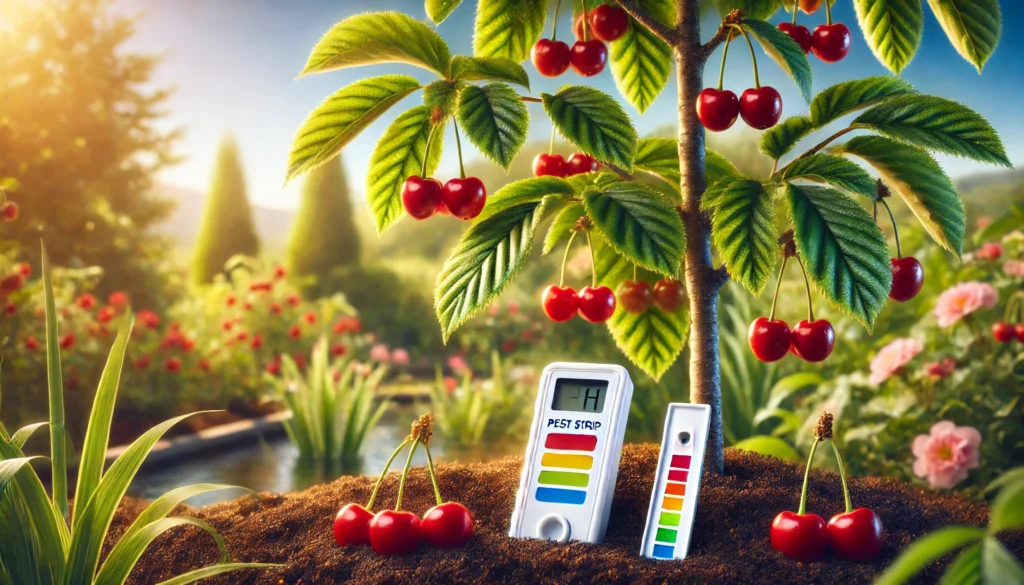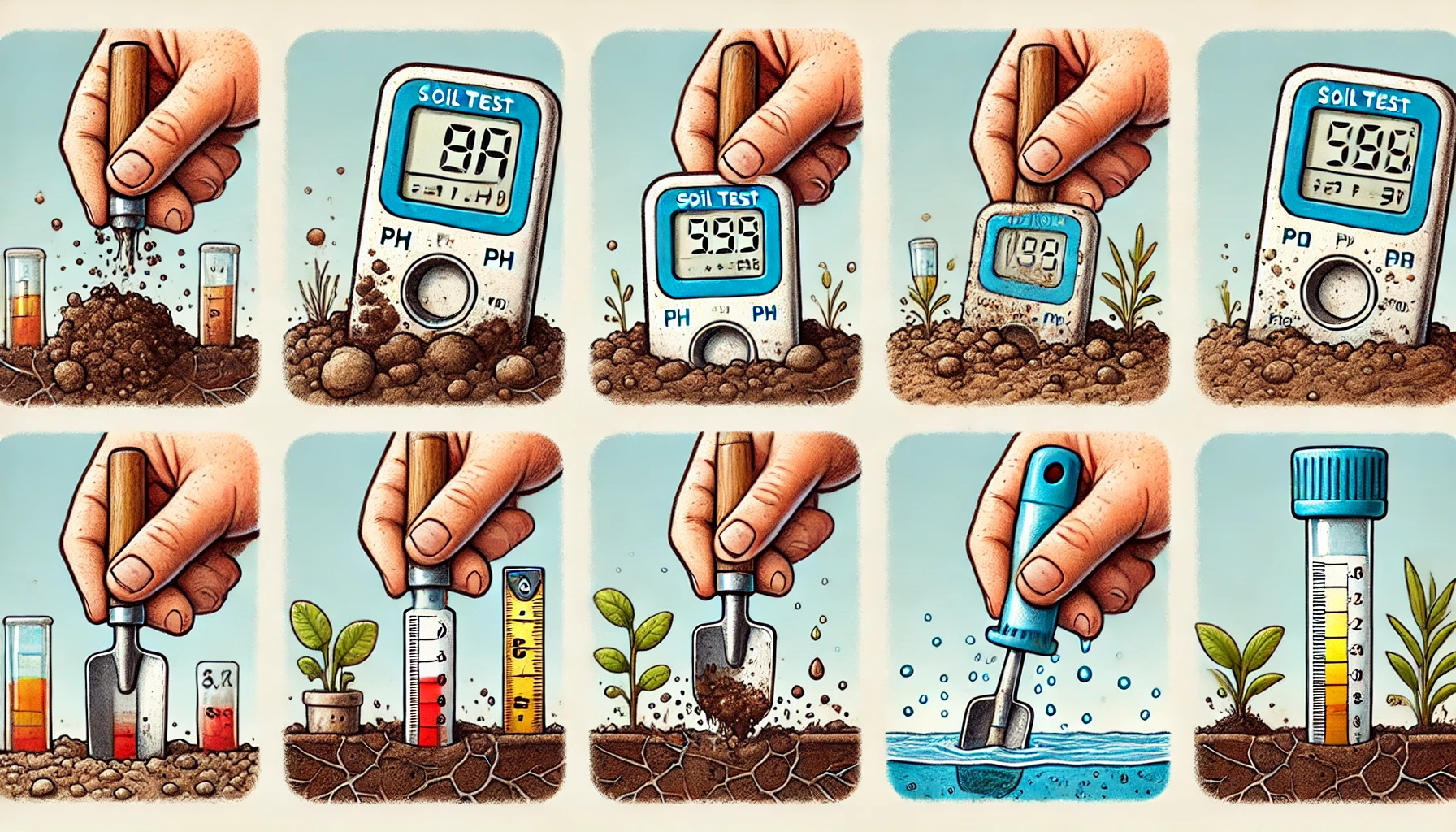
Cherry Tree Soil Testing: How to Ensure the Right pH Levels for Optimal Growth
When it comes to growing healthy, productive cherry trees, one of the most crucial factors is the soil they thrive in. Have you ever wondered why your cherry tree isn’t producing as much fruit as you’d hoped? The answer may lie in the pH levels of your soil. In this article, we’ll explore Cherry Tree Soil Testing: How to Ensure the Right pH Levels for optimal growth. Understanding the ideal pH range for your tree is key to unlocking its full potential, ensuring vibrant leaves, robust fruiting, and overall health. Let’s dive into how soil testing can make all the difference!
Table of Contents
ToggleWhy Soil pH Matters for Cherry Trees 
When it comes to growing healthy cherry trees, soil pH is one of the most crucial factors to consider. 
- Optimal pH Range for Cherry Trees
Cherry trees thrive in slightly acidic soil, with an ideal pH range of 6.0 to 6.8. This range ensures the best nutrient availability, allowing your cherry tree to absorb essential minerals like nitrogen, phosphorus, and potassium more efficiently. - Nutrient Absorption
Soil pH directly affects how well your tree can absorb nutrients. If the soil is too acidic (below 6.0) or too alkaline (above 7.0), the roots struggle to take up these vital nutrients, leading to poor tree growth and reduced fruit production.
- Disease Resistance
Maintaining the correct pH level helps cherry trees build stronger defenses against soil-borne diseases. A balanced pH promotes healthy root development, making the tree less vulnerable to harmful pathogens. - How to Test Soil pH
You can easily test your soil pH with a simple soil test kit or by sending a sample to a local agricultural extension service. This will give you a clear picture of your soil’s condition, allowing you to make any necessary adjustments. - Adjusting Soil pH
If your soil pH is too high or too low, you can amend it. To lower pH (make it more acidic), add sulfur or compost. To raise pH (make it more alkaline), add lime. Always follow instructions carefully and test the soil regularly to keep it within the optimal range.
By understanding and maintaining the right soil pH, you’ll set your cherry trees up for success, leading to healthier growth and a bountiful harvest!
The Ideal pH Range for Cherry Trees 
When it comes to growing healthy cherry trees, understanding the ideal pH range for the soil is crucial. Cherry trees thrive best in slightly acidic to neutral soil, with a pH level between 6.0 and 7.5. This range provides optimal conditions for nutrient absorption, ensuring robust growth and delicious fruit.
If the soil is too acidic (pH below 6.0), cherry trees may struggle to take up essential nutrients, which can lead to poor growth and weak fruit production. On the other hand, overly alkaline soil (pH above 7.5) can cause similar issues, as the tree won’t be able to access key nutrients effectively.

Maintaining the right pH will promote a healthier cherry tree and a better harvest 
How to Test Soil pH for Cherry Trees 
Testing your soil’s pH is crucial for cherry tree health 
- Purchase a pH Test Kit or Meter
- pH Test Kits: Easy to use, just mix soil with water and dip the pH strip into the solution.
- Digital pH Meter: Provides quick, accurate readings by inserting the probe into moist soil.
- Collect Soil Samples
- Take samples from multiple spots around the root zone (6-8 inches deep).
- Mix the samples to get an accurate overall reading.

- Test the Soil
- Follow the instructions on your test kit or meter. If using a digital meter, ensure it’s calibrated for accuracy.
- Interpret the Results
- A pH of 6.0-7.0 is perfect for cherry trees. If your soil is too acidic (below 6.0), you can add lime to raise the pH. If it’s too alkaline (above 7.0), sulfur or peat moss will help lower it.
- Repeat Regularly
- Test your soil every 1-2 years to ensure it stays in the ideal range for optimal cherry tree growth.
- Test your soil every 1-2 years to ensure it stays in the ideal range for optimal cherry tree growth.
By regularly testing your soil’s pH, you ensure that your cherry trees get the best nutrients they need to thrive!
How to Adjust pH Levels for Cherry Trees 
Maintaining the right pH level for your cherry trees is essential for their health and productivity. Cherry trees thrive in slightly acidic soil, with an ideal pH range between 6.0 and 6.5. Here’s how you can adjust the pH to help your trees grow strong and healthy.
1. Test Your Soil pH 
Start by testing the soil using a pH testing kit, which you can easily find at garden centers or online. This will give you a clear understanding of your soil’s current pH level.
2. Lowering pH (Making Soil More Acidic) 
If the pH is too high (alkaline), you can lower it by adding organic matter like pine needles or peat moss. These will naturally acidify the soil over time. You can also use sulfur or aluminum sulfate, which quickly lowers the pH.

3. Raising pH (Making Soil More Alkaline) 
If your soil is too acidic, you can raise the pH by adding agricultural lime or dolomitic lime. These will help neutralize the acidity and make the soil more alkaline, which is not ideal for cherry trees but necessary if the pH is too low.
4. Regular Monitoring 
After making adjustments, monitor the pH levels regularly (every few months) to ensure they stay within the ideal range for cherry trees. Soil conditions can change over time, so consistent care is key.
By following these simple steps, you’ll help your cherry trees thrive and produce abundant, delicious fruit!
Other Factors That Affect Cherry Tree Growth 

When growing a cherry tree, several factors beyond basic care play a key role in its success. Here’s what you need to know to keep your cherry tree thriving:
1. Sunlight Exposure 
Cherry trees thrive in full sunlight, needing at least 6 hours of direct sunlight per day. Sunlight helps them produce energy through photosynthesis, promoting healthy growth and fruit production. Ensure your tree gets enough sun by planting it in a spot that isn’t shaded by larger trees or structures.

2. Watering Needs 
Cherry trees need consistent watering, especially during dry spells. However, they don’t like sitting in waterlogged soil. Make sure the soil is well-drained to avoid root rot. Water deeply but infrequently—aiming to keep the soil moist, not soggy.
3. Soil Quality 
Healthy, well-draining soil is essential for cherry trees. They prefer slightly acidic to neutral soil (pH 6.0–7.0). Before planting, check your soil’s drainage and pH levels, and amend as needed with compost or organic matter to improve its texture and fertility.
4. Temperature Extremes 
Cherry trees are sensitive to extreme temperatures. They grow best in temperate climates with cold winters and mild summers. If you live in an area with harsh winters, consider planting a cold-hardy variety. Too much heat can also stress the tree, so provide shade during extreme heat waves if necessary.
5. Pollination 

Many cherry tree varieties require cross-pollination for optimal fruiting. Plant at least two compatible varieties nearby to ensure a good crop. Attract pollinators like bees by keeping your garden vibrant with flowers they love.
By considering these factors—sunlight, water, soil, temperature, and pollination—you’ll set your cherry tree up for a healthy and productive life.
Common Mistakes to Avoid with Soil pH Testing 
Soil pH testing is essential for optimal plant health, but common mistakes can lead to inaccurate results. Here are some key mistakes to avoid:
- Not Testing at the Right Depth
Always test soil at the correct depth (about 2-4 inches) where most plant roots are active. Testing too shallow or too deep can give misleading results. - Using an Old or Dirty pH Meter
An old or poorly maintained pH meter can skew your readings. Clean the probe after each use and replace it regularly to ensure accurate measurements. - Testing Wet Soil
Testing soil right after heavy rain or watering can affect the pH level. Allow the soil to dry slightly before testing for the most reliable results.
- Not Sampling From Multiple Areas
Soil pH can vary across your garden. Take samples from different spots and mix them to get a more accurate representation of your soil’s pH. - Relying on Only One Test Method
Don’t depend solely on a single pH testing method. Cross-check results from multiple methods (like kits and meters) for better accuracy. - Ignoring the Soil’s Temperature
Soil temperature can influence pH readings. Try testing when the soil is at a moderate temperature, ideally between 50-70°F (10-21°C).
By avoiding these common errors, you’ll get more precise soil pH readings, ensuring your plants thrive!
Final Tips 

Ensuring the right pH levels for your cherry tree is essential for promoting healthy growth and maximizing fruit production. By understanding Cherry Tree Soil Testing: How to Ensure the Right pH Levels, you can take the necessary steps to optimize your soil for your tree’s needs. Regular soil testing, along with adjustments when necessary, will provide your cherry tree with the ideal environment to thrive.

Remember, soil pH is just one piece of the puzzle. Combining proper pH levels with good watering practices, well-drained soil, and proper fertilization will give your cherry tree the best chance at success. Stay proactive with testing and care, and watch your cherry tree flourish year after year. Happy gardening!
Frequently Asked Questions(FAQ)
Why is soil pH important for cherry trees?
Soil pH affects the availability of nutrients in the soil. If the pH is too high or too low, it can hinder your cherry tree’s ability to absorb essential nutrients, leading to poor growth, weak fruit production, and even susceptibility to diseases.
How can I test the pH of my soil?
You can test your soil pH using DIY soil test kits available at garden centers, or you can send a sample to a local agricultural extension or professional lab for more accurate results.
What is the ideal pH range for cherry trees?
Cherry trees thrive in soil with a pH range of 6.0 to 7.0, which is slightly acidic to neutral. This pH range ensures optimal nutrient availability for your tree.
How do I raise the pH of my soil?
If your soil is too acidic (below 6.0), you can raise the pH by adding lime or dolomitic lime to the soil. Be sure to follow the recommended application rates based on your soil’s current pH and the type of lime you’re using.
How do I lower the pH of my soil?
To lower soil pH, you can add sulfur or organic matter like pine needles or composted leaves. These amendments help increase soil acidity over time.
How often should I test my cherry tree’s soil pH?
It’s recommended to test your cherry tree’s soil pH at least once a year, ideally before planting or during the growing season, to ensure your tree is getting the nutrients it needs.
Can I over-correct soil pH for my cherry tree?
Yes, over-correcting can lead to an imbalance in your soil. For example, adding too much lime can make the soil too alkaline, which could negatively affect the tree’s health. Always follow application guidelines and test regularly.
Can I use the same soil test results for other plants in my garden?
Yes, the results of your soil pH test can be used for other plants in your garden, but different plants have different pH preferences. Make sure to adjust accordingly for each plant’s specific needs.










